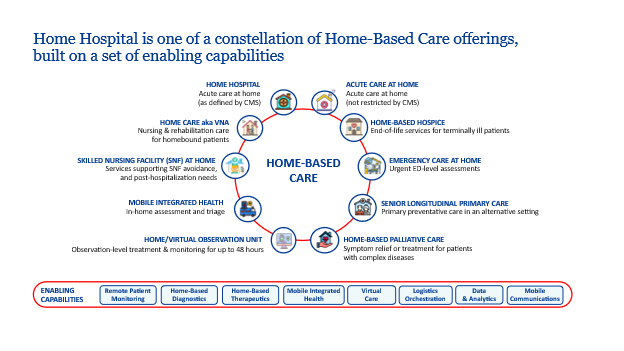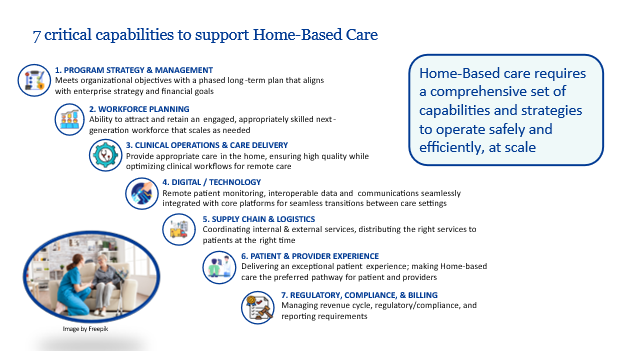 One of the most profound shifts in modern healthcare isn’t happening inside hospitals or doctor’s offices, it’s happening at home. Across the country, health systems, payers, providers, and tech innovators are accelerating the move toward care-at-home models that offer high-quality, lower-cost, patient-centered alternatives to traditional facility-based care.
One of the most profound shifts in modern healthcare isn’t happening inside hospitals or doctor’s offices, it’s happening at home. Across the country, health systems, payers, providers, and tech innovators are accelerating the move toward care-at-home models that offer high-quality, lower-cost, patient-centered alternatives to traditional facility-based care.
As someone who has spent decades building digital strategies across the inpatient and ambulatory continuum, I believe care at home is no longer a pilot or niche program: it is an integral part of the future operating model for healthcare. And it’s taking shape faster than many realize.
From Concept to Core Strategy
Care at home is a broad category encompassing traditional home care (VNA), subacute care, acute care at home, remote patient monitoring, chronic disease management, palliative care, and, at its most advanced, hospital-at-home programs. What began as a COVID-era necessity has matured into a long-term strategic priority.
Today, leading organizations are embedding home-based care into their core operations: scaling with intent, integrating digital infrastructure, and aligning with emerging financial models. Why? Because the benefits are becoming too significant to ignore. Health systems nationwide are reporting:
- Reduced capacity constraints
- Lower total cost of care
- Fewer readmissions and complications
- Higher patient, family, and clinician satisfaction
- Expanded access, especially for high-risk and underserved populations
What was once reactive and episodic, a constellation of home-based solutions is enabling proactive, longitudinal care powered by foundational capabilities including digital tools and real-time data.

Digital Infrastructure Is the Enabler
The rapid growth of care-at-home models is being powered by digital transformation. Virtual care platforms, remote monitoring, cloud-based orchestration tools, third-party integrations, and sophisticated analytics are no longer optional, they are foundational.
Whether it’s a nurse monitoring vitals remotely, a family caregiver coordinating through a mobile app, or a centralized command center managing home hospital admissions, digital integration is what makes these models scalable and sustainable.
But it goes deeper. Home-based care must operate within a broader ecosystem, clinically and financially on par with inpatient and ambulatory services. This demands intentional digital investment: interoperability, mobile workforce enablement, patient engagement tools, and logistics platforms. Third-party service providers must be integrated, and complex workflows are reengineered for mobile, decentralized delivery.
Care at home isn’t just about extending clinical services, it’s a full-stack operational redesign of service delivery requiring strategy, governance, and change management across people, process, and technology.

Home Hospital: A High-Acuity Success Story
Among home-based care models, home hospital has emerged as one of the most promising. For patients who meet clinical criteria, it offers a full suite of hospital-level services delivered safely at home.
In markets where it has been implemented at scale, home hospital programs have shown:
- 30–50% lower cost per episode
- Equal or better quality and outcomes, with lower mortality
- Shorter inpatient lengths of stay
- Higher patient and staff satisfaction
But beyond the data, home hospital demonstrates what’s possible when we rethink care delivery. It shows that much of what was once locked inside the hospital can be reimagined for the home without compromising safety, quality, or outcomes.
A System-Level Imperative
This shift is not just clinical, it’s strategic. Healthcare systems are facing unprecedented pressure: workforce shortages, capital constraints, changing consumer expectations, and a growing emphasis on value. Care-at-home models help address all of these by:
- Freeing up facility capacity
- Reducing reliance on new construction
- Improving workforce flexibility
- Expanding reach into the community
- Advancing equity by meeting patients where they are
The economic case is equally compelling: avoided capital expenses, improved throughput, new revenue streams, and better alignment in risk-bearing payment models.
Yet despite the upside, many health systems remain cautious, especially with home hospital care, due to policy uncertainty. The CMS Acute Hospital Care at Home waiver has been extended annually since 2020 but lacks a long-term guarantee. That uncertainty has led most provider organizations to sit on the sidelines or operate in limited pilot mode; meanwhile vendors and service providers (and their financial backers) are limiting their investments until they have a longer runway.
By contrast, in value-based care environments, care-at-home models have gained more traction, thanks to clearer financial alignment and fewer regulatory constraints.
Looking Ahead
We are at a tipping point. The question is no longer, “Can we deliver care at home?” but “How do we scale it equitably, efficiently, and sustainably?”. And equally important: “Do the economics work at scale?”. Care at home, across the continuum, is becoming central to how we define access, quality, and value in healthcare. It’s not just a service line; it’s a new system architecture.
We’re not simply moving care out of the hospital. We’re moving healthcare forward.
StarBridge Advisors has the experience and knowledge to help design and implement the complex digital services needed to support your initiatives to move care out of the hospital. We are ready to partner with you and your team on this journey.
